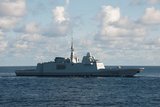Raytheon GPS OCX completes preliminary design review
Raytheon Company has successfully completed preliminary design review for the Global Positioning System Next Generation Operational Control System (GPS OCX), an important milestone in determining the program's development approach, cost estimates and delivery schedule. The review, which was conducted by the US Air Force Space and Missile Systems Center's (SMC) GPS Directorate, assessed the architectural and technical maturity of the program design.
"Successful completion of the PDR is a significant milestone validating our design and confirming the Raytheon-led team's proven capabilities and commitment to delivering GPS OCX Block 1 on time and on budget," said Lynn Dugle, president of Raytheon Intelligence and Information Systems.
"Our successful PDR results demonstrate that the program's design maturity meets the MIL-STD-1521B standard and will allow the team to proceed with the completion of the next phase of development in preparation for GPS III launch in 2014," said Robert Canty, vice president and GPS OCX program manager for Raytheon's Intelligence and Information Systems business.
GPS OCX is the next generation operational gateway service designed to provide secure, accurate and reliable navigation and timing information to effectively support military, commercial and civil users. GPS OCX will be the service integrator between ground, space and user segments to enhance mission command and control, and situational awareness capabilities, while seamlessly supporting billions of users around the world.
"By acting as a service bridge between the space and user segments, GPS OCX will enable an innovative, user-centric system, allowing users to experience the benefits of advanced technologies aboard satellites already in orbit and those yet to be built," Canty added. "The OCX segment will increase system capacity and support the new GPS III satellites -- which the current GPS control segment cannot -- and is scalable to support future growth."
The OCX segment updates GPS command and control (C2) and mission management capabilities, transforming the focus of GPS operations from satellite C2, to user-oriented, effects-based operations. In addition, GPS OCX will facilitate additional civil signals (L1C, L2C and L5) and new signal structures (M-Code) to provide navigation integrity, improved accuracy and increased availability.
Source: Raytheon
More from Digital Battlespace
-
![Babcock nears first customer for Nomad AI translation tool]()
Babcock nears first customer for Nomad AI translation tool
Nomad can provide militaries with real-time intelligence, saving critical time on the battlefield.
-
![AUSA 2025: Israel’s Asio Technologies to supply hundreds of improved Taurus tactical systems]()
AUSA 2025: Israel’s Asio Technologies to supply hundreds of improved Taurus tactical systems
Taurus operates alongside the Israel Defense Forces’ Orion system which supports mission management across tens of thousands of manoeuvring forces, from squad leaders to battalion commanders.
-
![AUSA 2025: Kopin pushes micro-LED plans as China moves faster]()
AUSA 2025: Kopin pushes micro-LED plans as China moves faster
The plan for the new displays follows fresh investment in Kopin’s European facilities by Theon and an order for head-up displays in fielded aircraft, with funding from the US Department of Defense.
-
![AUSA 2025: Persistent Systems to complete its largest order by year’s end]()
AUSA 2025: Persistent Systems to complete its largest order by year’s end
Persistent Systems received its largest ever single order for its MPU5 devices and other systems earlier this month and has already delivered the 50 units to the US Army’s 4th Infantry Division.
-
![Aselsan brings in dozens of companies and systems under the Steel Dome umbrella]()
Aselsan brings in dozens of companies and systems under the Steel Dome umbrella
Turkey has joined the family of countries attempting to establish a multilayered air defence system with government approval in August 2024 for the effort landed by Aselsan. Dubbed Steel Dome, the programme joins Israel’s Iron Dome, the US Golden Dome, India’s Mission Sudarshan Chakra and South Korea’s low-altitude missile defence system.
-
![DSEI 2025: MARSS unveils new agnostic multidomain C4 system]()
DSEI 2025: MARSS unveils new agnostic multidomain C4 system
MARSS’ NiDAR system has been deployed using sensors from static platforms to provide detection and protection for static sights, such as critical infrastructure, ports and military bases.




























